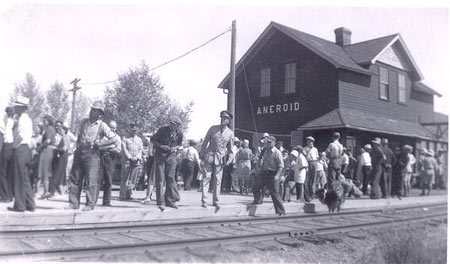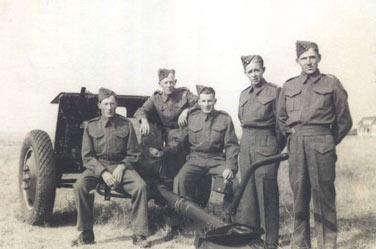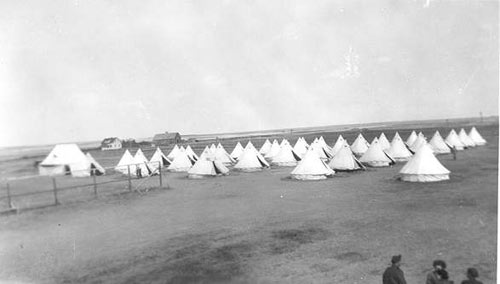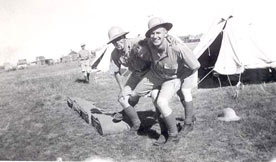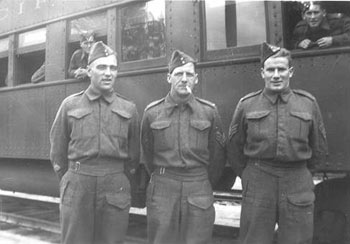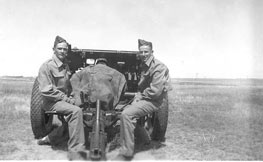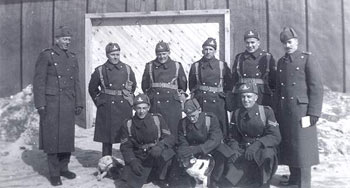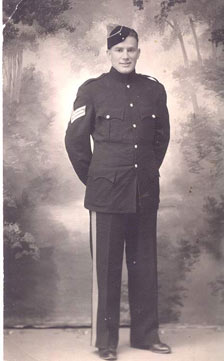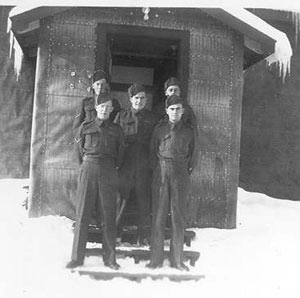Memoirs of Gordie Bannerman
Enlistment and Training
The war broke out in September 1939, as I was just turning 18. It was impossible to join active service at that time. I was in grade 12 and hoped to graduate. In the spring of 1940, our school teacher belonged to the 60th Field Battery RCA (Militia), so a group of us would go to the town of Aneroid to do gun drill once a week. I could hardly wait until I could join up.
At this time, the allies were kicked off the continent at Dunkirk. I remember my Dad, a WWI veteran, with tears in his eyes saying, "If I were young enough I would go and see what I could do.” Summer came and four of us went to summer camp at Dundurn (military camp in Saskatchewan). We were there for about ten days when the 14th Canadian Light Horse mobilized for active service. My buddies said they were to wait for the 60th to mobilize, so we took the train home. And in a couple of days the 60th Battery went active. I was 18 and Orme, my school buddy, the same. A couple of phone calls to each other, we talked to our parents, and away we went.
We travelled to Aneroid, a 40 mile drive, and proceeded to join up. When the officer asked how old I was I said, "You know!", as he was my teacher that year. I said, “18.” He said, “Have you your parents consent?” and I said, “Yes.” Quietly, he said “We will make you 19.” And the discrepancy stayed with me until I took my discharge in 1946. So the great adventure was ready to begin. The date July 23, 1940. We were active service and proud members of the 60th Field Battery RCA CASF.
When we young fellows arrived in Aneroid, Saskatchewan to join the 60th Battery RCA, we were some of the first arrivals and were billeted for a few days with the local people. This was due to not having tents or a kitchen set up. Then on July 23, 1940, we were medically checked, and if we passed the medical we gave our oath of allegiance to serve then HRH King George, to serve in the forces for the duration of hostilities and a year after as his Majesty saw fit. Now we had a regimental number, mine being L35064. The “L” signifying the Military district #12.
Tents arrived and we no longer were billeted or ate in the cafe. Tents were set up in straight lines, kits issued, summer drill pith helmets, puttees army shoes, pt shoes, underwear, shirts, shorts, shaving gear, razor, shaving brush, shoe brushes, and even sewing kit thread, wool for darning socks and needles, also spare buttons. We were four to a tent and we had blankets issued and a bag called a paillasse. This we stuffed with straw from a nearby farm for a mattress. The battery had some officers that were militia men, some sergeants, and a first war sergeant major. We now were truly in the army! Guard duty and kitchen fatigue were the start. Morning roll call! Training was not too much at the start, as men were coming in every day until we were up to battery strength of about 200.
The Mounties even brought a few so called hobos off the freight train to join up or be locked up for vagrancy. We route marched and drilled for a month at Aneroid getting to know who our fellow gunners were. Also we thought we were pretty good and smart. So the local girls, which there seemed quite a few, we tried to outdo each other for their attention. We had a good ball team here and I was the pitcher, and Orme, my school buddy, the catcher. Now we were in shorts and short sleeved shirts, but we wanted to get our battle dress that would show we were active service. Why in the heat of dusty, dry, hot Saskatchewan we wanted the serge? Well, we were issued it and I went to a dance to show it, the battle dress, off and had the worst under arm scalding anyone ever had. So much for vanity.
The Aneroid stay we felt would soon be over and bigger events were to come. The last few weeks were one of meeting new people joining up and most of them would be our friends and fellow gunners for the next six years, although we thought the war would be over before we were ever in combat. How wrong we were!
Orders came out that we could invite family members to visit the battery on the next Sunday which was the end of August 1940. On the Monday we were told that in the next day or so we would be moving to Indian Head, Saskatchewan where the 76th Battery was mobilized and this was our sister battery. On the final day tents were taken down and rolled up and stored away. Kits were packed and we slept out in the open field so all we would have to do was have breakfast and catch the train for Indian Head. Morning came and we had our breakfast, marched down to the station and waited for the great adventure. Many had never rode on a train before, so it was waiting full of excitement, and of course letting on how we would write and never forget the friends and girls of Aneroid.
The train arrived, and on a hot summer day we were at last seated and on our way. It was a pretty slow train and, some of the fellows were very glum especially some of the married men who had left wives and family, teary eyed on the Aneroid station platform. Joe Schwarek and I were seated together and passed the time wondering what was in store for us, also watching the next station to appear. The rail line went along southern Saskatchewan and along the line turned north to Moose Jaw, Saskatchewan. Here the train had a long stop. Now we had quite a few Moose Jaw gunners whose wives and sweethearts were at the station to say hello and give and take a hug.
Some of the more thirsty fellows who knew the cabbies in Moose Jaw, pooled their money and brought a lot of beer on board the train. The run from Moose Jaw to Indian Head was a drunken comedy. On arriving at Indian Head and getting off the train, Sgt. Magor called us to fall in for the march to the barracks. We lined up and Major Jacobs called us to attention. Seven or eight gunners fell flat on their faces out like a light! The booze, not much food, and the extremely hot day caught up. What a sight! The sister battery and dignitaries were all there to see our arrival. We marched, some straggled, others were tossed into trucks and taken to the armoury. I think all eventually arrived and passed out. There were even a couple of broken windows on the train.
Right away we had a medical inspection with some members of our battery having measles, so those that never had measles were in one area, sort of quarantine, while those of us that had measles as children were in another group. Now there was a little animosity amongst the 76th Battery and we the 60th Battery that had arrived in such a terrible state. Those that had the measles could drink out of certain water taps and the others at other taps. This is where on the second day, when one of us went to drink out of the correct tap, we were pounced upon by a figure in really short shorts wearing two stripes, red moustache, spectacles and roaring that we could not drink water out of that tap. We informed him that was the tap designated for our use. With a bit of muttering he left, with us all saying what in hell was that all about.
That was our introduction to Bombardier George Hegan. Our officers that came with us were in conference it seemed for days. The up shot of this conference was to combine the two field batteries into one. Disappointment was the result. The new battery was to be called the 60/76 field battery, with three troops A, B, & C troops and a battery headquarters. Our major Clive Jacobs would now be the battery captain. The officer commanding would be Major Boulter, who was known to quite a few of our battery as he had been a school teacher in many areas of Southern Saskatchewan. Orders were posted and the rush to the bulletin board to see what troop you had been assigned to.
Out of all this, there was promotions and I ended up in B troop. The orders listing the promotions stated that on that date I was now an acting Lance Sergeant. Wow, this was a few days before my 19th birthday! Looking back, the responsibility so early in life stuck with me all the years. I often in retrospect think a sense of responsibility was a curse. You were a non commissioned officer, and immediately, you were not a part of that group you were part of just days before. You took on quite a different role, and hoped that it did not get your ego so high that you were going to be despised by the gunners you, days before, shared a tent with. You now shared a tent with sergeants from B troop who were, in most cases, older than you with years of militia experience.

Orme Payne, Gordie Bannerman, John Wiebe.
Being promoted to a Lance sergeant meant I would get $1.90 per day, an absolute fortune. The rate of pay for a gunner was $1.30 per day. Now seeing we're in troops, training started at a good rate. As we did not have any artillery pieces, the training was guard duty, route marches, close order drill, and being issued with more equipment. We were issued with web equipment here. How to put it all together? There was no one that had used this new type before. Well it all went together - big pack, small pack water bottle, ground sheet. Steel helmets did not come until later. During our time here, they had a family day. I was introduced to some of the fellows' wives as their Sergeant.
I had made up my mind that I was going to succeed and be a gun sergeant then if the war lasted and I survived to become an officer. Discipline came easy to me. I likely took myself fairly seriously and I suppose I lost a few gunner friends in doing so. But as the years went by I always was a voice to stand by those that needed a friend and someone to plead their case when they were in trouble. I was NCO that the gunners knew my word was good. The stay at Indian Head was short and soon we were to pack up and leave. Orders were posted to let us know we would leave in the next few days so we could have loved ones to see us off.
This is where you made friends for life, also found out who knew their stuff, who were brown noses, and who loved life. This latter group were the ones that really counted. Some did not survive, but they enjoyed life and lived for the moment. Some of my best friends were also promoted here, and one in particular was Orme Payne who went to school with me, and all through the war, and home together. We left Indian Head on the October 4, 1940 by train, and meeting up with another train at Portage La Prairie. This other train had the 37th Field Battery on board. Our destination was Petawawa, Ontario, with the Ottawa River on one side, and the Petawawa River on the other. On arriving at camp we were soon in the furthest away lines of huts, as the camp was being expanded to house hundreds more. The lines were alphabetical and ours were the V lines.

Gordie, Orme, Floyd and Elmer at Petawawa in 1940.
Petawawa was to be our home for the next 13 months, although we did not know it at the time. When we settled into camp, we were soon to find out that the 37th Field Battery had supplied the advance party and had arrived in Petawawa some days ahead of us. Right away there was a lot of jealousy and petty attitudes between the 37th Battery and the 60/76th Battery. The 37th came from Portage la Prairie, Manitoba, Kenora, Ontario and other Ontario towns. The 60/76th Battery came from small prairie towns in Saskatchewan.
Now the barracks were great to all of us who, up to now, had spent our first few months in the army under tents. They were the “H” huts, each leg of the “H” with at least 80 men in double deck bunks. The joint of the legs held the washroom and drying room. Each leg had a large coal and wood fired heater with a long line of stove pipe running to the outside. Hut orderlies kept the fires stocked up with fuel during the night. These stoves glowed red with heat, and on occasion someone whether by accident, or just being an ass, would get up and pee a bladder of Black Horse induced pee on this red hot stove. I will let you imagine the stench that assail the nostrils of all in the hut, followed with a lot of cursing the peeing individual.
Sometimes one leg of the “H” would raid the other leg. All after lights out. The rallying cry was “prepare to repel boarders,” and there in the glow of a red hot stove fifty gunners would get into a pillow fight. Pillows would burst and on occasion the stove pipes would come down. After a good sortie the clean up would start all without turning on the light. Feathers stuffed back in pillows, stove pipes put up, and the barracks in order for morning inspection. Mind you most of these fellows were just boys, with a sprinkling of old timers. Some of these oldsters were likely about thirty. Showers were always available.
I was in the 60/76th sergeants’ hut and ate in the sergeants’ mess and drank in the sergeants’ bar or mess. The other ranks had a wet canteen, and the officers had their mess complete with bar and gunners to do the duties in this area. Petawawa was a big camp and there were other artillery units there. The numbers were in the hundreds of all ranks. The RCE had a canteen called the Merry Sappers Canteen. Now this canteen had a couple of WWI engineers who were black. These chaps were in their forties and I can see them now. They were two of the most entertaining con men you ever met. Here we were a group of prairie boys who were not used to seeing blacks unless we had seen one as a sleeping car porter on a train or a touring ball team called the Colored House of David. These fine old fellows probably conned every one of us to buy them a drink. They were the greatest, and I will always remember their laughs, their humour, and they knew what war was all about and had survived.
The Salvation Army had a hut also the YMCA and the Knights of Columbus. These were service huts that sold food, chocolate bars, and souvenirs, and supplied free writing material. The Sally Ann was the greatest. It was operated by a Major Watters and Mother Watters as he called his wife. He, the Major, could pick out a homesick boy, steer him over to Mother Watters and some other motherly ladies, likely have a free cup of tea and get his uniform fitting better and his unit flashes sewn on by the ladies. I have never forgotten them! At closing time they gave away any of the cookies and doughnuts that had not sold, and none of the other service clubs ever did this.
Life in a large army camp was certainly new to most of us, and each day something else came up. The introduction to the down east strong, Black Horse, Molson's, Kingsbeer, and Carling Red Cap beers was something that took some getting used to, especially, as most of the beer was in quart bottles. Our training started to take a new turn. Most of our battery officers were attending classes to check their ability of the fundamentals of being an artillery officer. It seemed we were being given foot drill by officers from the 37th battery who were not the most pleasant to we western chaps, and they seemed to be able to point out shortcomings in our non commissioned ranks, sometimes with malice. The garage and the gun shed were under the control of the 37th Battery so things used to get a bit sticky when returning a vehicle to the garage, having every scratch or speck of dust pointed out to you. But we prairie fellows rode this out with pride and a silent curse under our breaths.
It seemed that we did hours of parade square drill, with little time learning the rudiments of the guns. The guns in question were a couple of 18 pounders, field pieces from WWI adapted to rubber tires. These were housed in a gun shed as winter was coming on and we were able, regardless of weather, to train on these guns. We were later to get 4.5 howitzers and more 18 pounders which we had outside in the spring, along with quads which were the name for the trucks that pulled the guns. All this we had lined up precisely in the gun lines.
Here is when a lot of the married men started to get home sick, a long way from home and their wives were likely writing how tough things were at home without them and the kids were being tough to handle. Or, in some cases, wives did not write and were seen at local dances with airmen from the Commonwealth training bases. Discipline came hard for a lot too. I took most of this in stride and kept a cheerful attitude, and found it much easier that way. The daily routine was steady and it soon became normal. You did your turn as guard sergeant, and orderly sergeant and drilled recruits. In between times you wrote a lot of letters, and drank your share of beer in the mess. All the time you tried to be a good soldier.
In 1940 we are at Petawawa Camp. It is almost Christmas and we were all hoping to get home for that day as we had now been away from home since the end of September. I was on the first group to get our Christmas leave, so we notified our parents, and of course girl friends, that we had left behind, that we would arrive by train on a certain date. We were all pretty excited to be able to get home. At this time the dress blue sales persons came into camp and were measuring up the fellows for dress uniforms. I think the price for a made to measure dress uniform was about thirty or so dollars. I saw the first uniforms come back into camp for the fellows and thought they looked pretty cheap.
Now in a very good shop in Pemberton was a mannequin wearing a terrific dress blue uniform. It was complete with lance sergeants stripes, so that just had to be mine. And if memory serves me correct, it was almost 60 dollars, an absolute fortune. But I had to have it! I sent home for the money and bought this set of blues. The day of departure could not come fast enough, and when the day came to get our passes our sergeant major and I had a disagreement and he held up my pass until it was only hours before train time. I sweated blood, but he was a small man and I think figured all including me was after his job. All I had in mind was getting my pass. At last the pass was grudgingly handed to me and I caught the leave truck to the CPR railway station and we were on our way going home for Christmas. Oh yes, with my dress blues well packed to show all it was going to be a leave to remember.
At last I was on my way home on Christmas leave, and here we were probably a hundred or more fellows heading home. After a two night two day trip the train pulled into the station at Swift Current, Saskatchewan and my folks were there to meet me. The last leg of the trip from Winnipeg to Swift Current was straight and fast across the prairie. It did not seem to go fast enough. The train was all troops, and there were not any niceties about it. Old time colonist cars that had a pull down type of wooden overhead bed without any mattress, bare wood and hard seats. But we were young, and on the way home for Christmas.
Arriving home was great. Mum of course had to feed me as she knew after that long train ride I would be hungry. How true. When I came home my folks were living on our farm and it was not too cold weather and no snow. I had brought home Maple Leaf hockey sweaters for my younger brothers and likely lockets and broaches with the artillery crest on them for my Mum and sister. I was in a hurry to get down to Aneroid to see Louise whom I had met in July of 1940 and I think I stayed a couple of days with Eric and Toots Corbin, friends of Louise and me. Eric Corbin at the time was also home on leave, he being in the same regiment as I. Louise was as charming as I had remembered and was glad to see me. Also her folks gave me a good welcome. I thought I was in love mind you. I think I wanted to get engaged, but Louise thought the war would and could last a long time. So we better wait until we saw how we felt in the ensuing years. Louise thought the dress blues made me look a handsome chap.
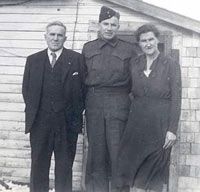
Gordie Bannerman and his parents Christmas 1940.
All too soon leave was over, and the thought of going back was just a day away. I had gone into Swift Current to be there to catch the early morning train going east, which would transport me to Petawawa Camp. I had on my dress blues as I had a photographer take my picture while wearing them. Going into a cafe I came under some ridicule from some other soldiers who thought the blues must be the Salvation army. I went back to the hotel and changed into battle dress to show these fellows I was regular active service, and doubted if they were.
My Dad was in Swift Current and saw in the photographer's window a framed picture of me in full colour, hand painted by the photographer. Dad bought the picture for my Mum, and Mum gave it to Edith and it hangs to this day 62 years later in our bedroom. The time came to catch the train at 5 a.m. and I was back to join our unit at Petawawa, taking with us just the memories of being home.

Don, Gordie and Arnie - February 14, 1941.
We always had the thought in mind what was going to happen next. More training, live ammunition shoots, and winter in Ontario. The month of January was rife with rumours that we were going to become a regiment instead of two batteries the 37th and the 60/76th batteries, also it took awhile for the Christmas leave rotation to complete. Meaning there were fewer troops around to do all the guard duties and other assorted duties, and at the same time try to do gun drill in a gun shed. Sometimes a troop would have only seven or eight to do this drill the rest were scattered on other duties.
January passed with some learning to ski patrol, others snowshoeing. The days passed quite quickly. The highlight of this was a firing demonstration by a crew of gunners from England, firing hundreds of 40mm shells out across the sky over the Ottawa River from a Bofors anti-aircraft gun. The automatic system that they could put the gun on were amazing.
On February 1, 1941, our first commanding officer arrived. His name was Lt. Col. W.C. Thackray. Along with the Colonel was Freddy Wright who would be our regimental quarter master sergeant major, title RQMS. Also the Colonel had our first regimental sergeant major with him. This was WO1, I. A. McLeod, title RSM. The regiment became known as the 17th Field Regiment Royal Canadian Artillery. We did finally and for all time be known as part of the 5th Canadian Armoured Division. The mighty Maroon Machine, as our shoulder patch was Maroon colored. The day we became a regiment was quite something with everyone reading great long lists of orders designating which battery or regimental Headquarters you were placed in. The regiment consisted of the Regimental HQ 60th battery, 37th battery, and the 76th battery. I thought I was fortunate to be posted to the 76th Field Battery and spent most of the next five years there with a short posting to Regimental HQ 17th Feb to July 22, 1944 as duty sergeant. Then on July 22, 1944, I was promoted to sergeant major and posted to Fox Troop 76th Battery.

Gordie Bannerman in his dress blues.
At the time the regiment was formed, a lot of discontent hit some of the fellows who hated to leave old friends in the battery they joined up with. As the years went by the regiment was second to none in esprit de corp, appearance, fighting expertise, gunnery, and anything that ever was asked. So from internal bitterness at the start, we soon melded into a first class fighting machine. A regiment we were all proud to have served with and we could not have had a better group of officers and men. Bless you all that have passed through the regimental roll. It was something to belong. The regiment was family and still in our hearts, it will always be!
I felt I was fortunate to be left with the 76th Battery as all of our chaps were ones that we had either joined up with or had met at Indian Head, Saskatchewan when we became 60/76 Field Battery. Total all ranks was almost 800, which included attached personnel. RSM Alec McLeod did quite a few things right away, having all warrant officers and sergeants moved into one hut. We were to get to know one another. The RSM maintained that the heart and soul of the regiment, whether it turned out good or terrible, depended on the WOs and sergeants, who if great, the regiment would be the best. This was always in our minds as we were the senior non commissioned officers, and we were responsible to see that the regiment was truly a unit that everyone would be proud to belong to. The RSM was a pretty good beer drinking permanent soldier, and liked nothing better than have the WOs' and Sergeants' mess full of chaps that drank.
I had a tolerance and could drink a fair amount more than some of the experienced drinkers who I thought made asses of themselves on not too many brews. I remember one time getting many Kingsbeer in me and as I had a healthy respect for the RSM, I took off my shoes when creeping past his door coming back to my bed. At this time I think I was the youngest gun sergeant in the regiment, so did not want to get in the RSM's bad book. Mind you a day or so later he said he had heard my not so quiet shoeless trip by his door.
The next week or so, more promotions and I became a gun sergeant, along with a great number of promotions throughout the regiment. I was one of 24 gun sergeants or #1's as we were called. We were a 24 gun regiment. We only had about half or less of that number of guns. During the winter of 1941 we trained on 18 pounder guns and 4.5 inch howitzers. These were the type of field guns from WWI modernized by mounting them on rubber tires instead of wooden wheels. The winter gun drill was carried out in a garage or gun shed and each troop took their turn doing the drill on the guns. This was a very cold damp winter and parade square drill was at a minium due to a lot of snow. Snowshoeing, and ski patrols were all carried out to keep us busy. Guard duty, fire pickets, kitchen fatigue, hut orderlies that stoked the coal burning fires in the huts. So if your troop was the duty troop, you would be only a few men left to do gun drill as all were on some other duty.
Battery discipline and regimental orders could be a bit much sometimes as everyone in authority was feeling his way, and getting his spot established on what he could or could not do. The warrant officers and sergeants seemed to get a lot of control, as the RSM had the Colonel's ear so to speak. Spring in Petawawa burst upon us and we welcomed the change in weather as it meant that we now did our training outdoors. Discipline and pride in ourselves was hammered into us. Soon we were believers that we were second to none in smartness and parade square soldiering. Soon the intensive training culminated in live ammunition shoots. We took to the ranges for this type of exercise and the thrill of, (we new sergeants), obeying fire orders, and firing the first live round. This was using shrapnel shell left over in great abundance from WWI. These were fixed rounds and had a fuse called T&P 80, or time and percussion 80. Here our officers were trained in observing the fall of shot and correcting this observation by degrees and yardage to finally have the rounds hit the target. All quite a lot of practice to get good. Some officers had a natural talent in making spilt second corrections relayed back to the guns and the results were a target hit very quickly.
In all the promotions, there was a down side. Our first sergeant, major Ken Cameron, a World War One veteran, was reduced in rank and spent some time drilling officer recruits at another camp. Ken did not get overseas with us. Then we were to lose Capt Peters and Capt Jacobs, both great men and officers, but classed as too old. Both were likely in their early forties. They had fought in WWI and we all thought they deserved better. But it was a new game and youth was the key. Soon we were brought up to officer strength by a lot of young officers, either from the ranks of the Royal Miliary college, or out of the eastern university officer training corp. The older officers that were transferred to non-combat units were prairie men who in the Colonel's wisdom thought they would not be tough enough to push us into the mold the Colonel had in mind. We missed these officers, but life went on, and we then trained the young officers.
The order of the day was a half hour of physical training before breakfast. Everyone had to do this exercise. Well the Colonel did not take part, so Sgt George Hegan used to march Fox Troop down under the colonel's window and bellow out the commands. George had a great roar of a voice. Well it got the desired effect of awakening the Colonel who opened his window and said: "Sgt. Hegan get the hell out from under my window right now," George said "Yes sir" and departed with his troop, never to wake the old man again. We were to get a lot of new recruits in to bring the regiment up to the required number, so all of we sergeants spent hours doing parade square drill, so much we used to dream of this at night and some of the sergeants hollered out the drill orders in their sleep causing the rest of us thinking of putting a sock in their mouths.
I could go on how some of my fellow sergeants appeared to this farm boy, but I will remember those older chaps that took me under their wing. In our quarters my single cot was between Ken Lovering and Art Cheney, two older fellows from Port Arthur. Great fellows and had a kind word and a few words of advice for me. Ken survived the war and was the only Sgt Major that was wounded. Art left us in Canada, I believe on medical grounds.
It is spring in Ontario and we were now getting into the feeling of being a regiment, and were getting more training all the time, also we suffered through the regimental parades that were for our Colonel Thackray's inspection. But most often it was for some visiting Brigadier General or higher ranking officers who, it seemed, never were at the designated inspection area on time. Standing in the hot sun with full packets with the what are we waiting for attitude. But we survived and all of this seemed to teach us something. At the time we sort of had that song in mind, "Always Bloody Well Waiting.”
Training on the gunnery ranges in Petawawa was something new, and the thrill of firing live ammunition was the culmination of what we were. All the live firing was carried out by experienced personnel watching all our moves. But one will never take away that first round that you fired. The sharp crack of the 18 pounder, the muzzle flash, the long recoil of the gun barrel, and of course the recuperators putting the barrel back to firing position once again. What a moment! Then if the weather was just right you could see the shell arch into flight going away to the distant target. Hoping that you had given the right information to your gun layer and he did not make a mistake because you checked and hoped that the observation officer had made the correct call and the target was hit.
The 4.5 Howitzers were different than the 18 pounder as they fired a larger shell, but the ammunition was not fixed. You rammed home the shell then placed bags of cordite in varying charge and the firing was done by pulling a lanyard. As the training progressed, we carried out fire and movement. That is where a troop of four guns or more were driving along a road, the signal would be given - action right or left or whatever, you swung off the road and put your guns ready for action, your gun position officer relating orders to the guns to fire on distant target. This target information came from observation officers who wanted to engage a target in a real hurry. Caused a lot of excitement and competition between troops and other batteries in the regiment, who could fire the first shot and hit the target with a round of gunfire from the whole troop. We never seemed to get enough live ammunition to fire, unless you were the ranging gun in the troop who certainly had their share.
I was then a junior gun sergeant and had the number three gun in the troop. In fact even when I was the senior sgt. in the troop, I still held on to my gun and did so until I was transferred to Regimental Head quarters. That gun was EC. The E was E troop third gun as the guns were abc&d in each troop, with the troop letter in front EA EB EC ED a four gun troop.
The summer of 1941 seemed in some way to be exceedingly long, but I am sure we did more parades for visiting dignitaries then any regiment in Petawawa. One thing I remember was that Fox Movietone came to Petawawa to film our guns firing. In a rest period they set the camera up behind my gun. So it was quite a thrill knowing the camera was rolling when our gun received the fire orders. I received the order to fire after getting all the proper orders, and I must say when the time came I hollered FIRE, and the gun layer Bombardier Gillespie pulled the trigger. The 18 pounder fired with an earsplitting crack, a flash of flame and smoke with the gun leaping on its rubber tires and the long recoil coming back toward you. The number four of the crew opening the breech and ejecting the cartridge case and readying another round to be loaded and fired. I do not remember how many rounds we fired for the film crew, but no matter it was quite a thrill.
Not all was training. Gunner Ooms, a Saskatchewan chap, was swimming in the pool caused by a back eddy in the river. Well he went under and did not resurface. Someone came running into camp for help. George Hegan and I heard the call so ran down to the river just in time to see Ooms' body being tumbled along the fast flowing river. George and I went to get him and we managed to get him onto the rocky shore. I was worried about covering Ooms nakedness. George said we are here to try and save his life not to worry about him being naked. George, using the methods of resuscitation, could not get any sign of life and the medical staff from camp came with a stretcher and took the body away. After it was all over I checked my watch. It was stopped, ruined by the water. A sweep hand watch was a must for a gun sergeant. It was a sad day when Ooms died as it was one of our first deaths and not by enemy action. As the years went by we were to experience many more.
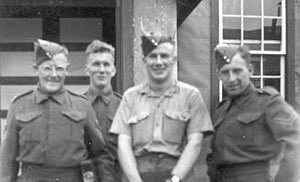
Petawawa in the summer of 1941.
Petawawa Camp was a memorable place. Letters were the means of communicating in those days, also the hope for a parcel from home with the things you did not get in the army. During our stay in Petawawa, the service clubs were active. The Salvation Army, and Knights of Columbus being two of the most predominant. The Sally Ann was really the best. Their good work continued overseas and they were always the nearest to the forward areas when we went into action.
The year of 1941 seemed to last forever as we did so many things. There were a lot of changes in the personnel, great talk of going overseas and the thought that the war might be over before we arrived over there. But the news from overseas in 1941 was generally that the allies were getting quite a kicking and Britain was still trying to rearm and equip her forces after the evacuation of Dunkirk the year before. The U-boats were sinking hundred of Allied ships. 1941 had some pretty dark days.
- Date modified:

